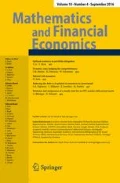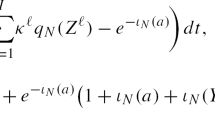Abstract
We examine the issue of sensitivity with respect to model parameters for the problem of utility maximization from final wealth in an incomplete Samuelson model and mainly, but not exclusively, for utility functions of positive-power type. The method consists in moving the parameters through change of measure, which we call a weak perturbation, decoupling the usual wealth equation from the varying parameters. By rewriting the maximization problem in terms of a convex-analytical support function of a weakly-compact set, crucially leveraging on the work (Backhoff and Fontbona in SIAM J Financ Math 7(1):70–103, 2016), the previous formulation let us prove the Hadamard directional differentiability of the value function with respect to the market price of risk, the drift and interest rate parameters, as well as for volatility matrices under a stability condition on their Kernel, and derive explicit expressions for the directional derivatives. We contrast our proposed weak perturbations against what we call strong perturbations, where the wealth equation is directly influenced by the changing parameters. Contrary to conventional wisdom, we find that both points of view generally yield different sensitivities unless e.g. if initial parameters and their perturbations are deterministic.
Similar content being viewed by others
References
Backhoff, J.: Functional analytic approaches to some stochastic optimization problems. PhD Thesis, Humboldt-Universität zu Berlin (2015)
Backhoff, J., Fontbona, J.: Robust utility maximization without model compactness. SIAM J. Financ. Math. 7(1), 70–103 (2016)
Backhoff, J., Silva, F.J.: Sensitivity results in stochastic optimal control: a Lagrangian perspective. ESAIM Control Optim. Calc. Var. 23(1), 39–70 (2017)
Bonnans, J.F., Shapiro, A.: Perturbation Analysis of Optimization Problems. Springer, New York (2000)
Cadenillas, A., Karatzas, I.: The stochastic maximum principle for linear convex optimal control with random coefficients. SIAM J. Control Optim. 33, 590–624 (1995)
Chen, Z., Epstein, L.: Ambiguity, risk, and asset returns in continuous time. Econometrica 70(4), 1403–1443 (2002)
Cox, J., Huang, C.: Optimal consumption and portfolio policies when asset prices follow a diffusion process. J. Econom. Theory 49(1), 33–83 (1989)
Danskin, J.M.: The theory of max–min and its application to weapons allocation problems. In: Econometrics and Operations Research, vol. V. Springer, New York (1967)
Davis, M.: Optimal hedging with basis risk. In: From Stochastic Calculus to Mathematical Finance, pp. 169–187. Springer, Berlin (2006)
Delbaen, F., Schachermayer, W.: A general version of the fundamental theorem of asset pricing. Math. Ann. 300(3), 463–520 (1994)
Inada, K.: On a two-sector model of economic growth: comments and a generalization. Rev. Econ. Stud. 30(2), 119–127 (1963)
Karatzas, I., Lehoczky, J., Shreve, S.: Optimal portfolio and consumption decisions for a “small investor” on a finite horizon. SIAM J. Control Optim. 25(6), 1557–1586 (1987)
Karatzas, I., Lehoczky, J., Shreve, S., Xu, G.L.: Martingale and duality methods for utility maximisation in an incomplete market. SIAM J. Control Optim. 29, 702–730 (1991)
Karatzas, I., Shreve, S.: Methods of mathematical finance. In: Applications of Mathematics, vol. 39. Springer, New York (1998)
Kardaras, C., Žitković, G.: Stability of the utility maximization problem with random endowment in incomplete markets. Math. Finance 21(2), 313–333 (2011)
Kramkov, D., Schachermayer, W.: The asymptotic elasticity of utility functions and optimal investment in incomplete markets. Ann. Appl. Probab. 9(3), 904–950 (1999)
Kramkov, D., Sîrbu, M.: On the two-times differentiability of the value functions in the problem of optimal investment in incomplete markets. Ann. Appl. Probab. 16(3), 1352–1384 (2006)
Larsen, K.: Continuity of utility-maximization with respect to preferences. Math. Finance 19(2), 237–250 (2009)
Larsen, K., Mostovyi, O., Zitkovic, G.: An expansion in the model space in the context of utility maximization. arXiv:1410.0946v1 [q-fin.PM] (2014)
Larsen, K., Zitković, G.: Stability of utility-maximization in incomplete markets. Stoch. Process. Appl. 117(11), 1642–1662 (2007)
Merton, R.: Lifetime portfolio selection under uncertainty: the continuous-time case. Rev. Econom. Stat. 51, 247–257 (1971)
Merton, R.: Optimum consumption and portfolio rules in a continuous-time model. J. Econom. Theory 3(4), 373–413 (1971)
Mocha, M., Westray, N.: The stability of the constrained utility maximization problem: a BSDE approach. SIAM J. Financ. Math. 4(1), 117–150 (2013)
Monoyios, M.: Malliavin calculus method for asymptotic expansion of dual control problems. SIAM J. Financ. Math. 4(1), 884–915 (2013)
Mostovyi, O., Sirbu, M.: Sensitivity analysis of the utility maximization problem with respect to model perturbations. arXiv:1705.08291 (2017)
Musielak, J.: Orlicz Spaces and Modular Spaces. Lecture Notes in Mathematics, vol. 1034. Springer, Berlin (1983)
Nakano, H.: Generalized modular spaces. Stud. Math. 31, 439–449 (1968)
Penot, J.P.: Calculus Without Derivatives. Graduate Texts in Mathematics, vol. 266. Springer, New York (2013)
Pham H (2009) Continuous-time stochastic control and optimization with financial applications. In: Stochastic Modelling and Applied Probability, vol. 61. Springer, Berlin
Pliska, S.: A stochastic calculus model of continuous trading: optimal portfolios. Math. Oper. Res. 11(2), 370–382 (1986)
Protter, P.: Stochastic Integration and Differential Equations, 2nd edn. Springer, Heidelberg (2005)
Quenez, M.C.: Optimal portfolio in a multiple-priors model. In: Seminar on Stochastic Analysis, Random Fields and Applications IV, vol. 58, pp. 291–321. Birkhäuser, Basel (2004)
Rogers, L.C.G., Williams, D.: Diffusions, Markov processes, and Martingales, Cambridge Mathematical Library, vol 2. Cambridge University Press, Cambridge (2000) (Itô calculus, Reprint of the second (1994) edition)
Weston, K.: Stability of utility maximization in nonequivalent markets. In: Forthcoming in Finance and Stochastics. arXiv:1410.0915v2 (2015)
Yong, J., Zhou, X.Y.: Stochastic Controls: Hamiltonian Systems and HJB Equations. Springer, New York (2000)
Author information
Authors and Affiliations
Corresponding author
Additional information
Julio Backhoff Veraguas is most grateful for partial support by the Austrian Science Fund (FWF) under grant Y782-N25 and the European Research Council (ERC) under grant FA506041, as well as to Humboldt-Universität zu Berlin and the funding by the Berlin Mathematical School. Francisco J. Silva acknowledges partial support by the Gaspar Monge Program for Optimization and Operation Research (PGMO).
Appendix A
Appendix A
We provide the proof of a version of the envelope or Danskin’s theorem (see [8]), adapted to our purposes. First, we recall the notion of Hadamard differentiability. Given two Banach spaces \((\mathcal {X}, \Vert \cdot \Vert _{\mathcal {X}})\) and \((\mathcal {Z}, \Vert \cdot \Vert _{\mathcal {Z}})\) a map \(f: \mathcal {X}\rightarrow \mathcal {Z}\) is directionally differentiable at x if for all \(h\in \mathcal {X}\) the limit in \(\mathcal {Z}\)
exists. If in addition, for all \(h\in \mathcal {X}\) the following equality in \(\mathcal {Z}\) holds
then we say that f is directionally differentiable at x in the Hadamard sense. An important property of Hadamard differentiable functions is the chain rule. More precisely, if \((\mathcal {V}, \Vert \cdot \Vert _{\mathcal {V}})\) is another Banach space, \(g: \mathcal {V}\rightarrow \mathcal {X}\) is directionally differentiable at v and f is directionally differentiable at g(v) in the Hadamard sense, then the composition \(f\circ g\) is directionally differentiable at v (see e.g. [4, Proposition 2.47]) and \(D(f\circ g)(v, v')= Df(g(v),Dg(v,v'))\) for all \(v'\in \mathcal {V}\). If in addition, g is is also Hadamard directionally differentiable at v, then \(f\circ g\) is directionally differentiable at v in the Hadamard sense.
Now, suppose that \(K\subseteq \mathcal {X}\) is a weakly compact set. Let us consider the problem:
where \(d\in \mathcal {X}^{*}\) and \(\langle \cdot , \cdot \rangle \) denotes the bilinear pairing between \(\mathcal {X}\) and \(\mathcal {X}^{*}\). Let us define \(v: \mathcal {X}^{*} \rightarrow \mathbb {R}\) as the optimal value of problem \((AP_{d})\) and \(\mathcal {S}(d)\) the set of optimal solutions of \((AP_{d})\), i.e.
Note that v is well defined, it is a Lipschitz function and \(\mathcal {S}(d)\ne \emptyset \). In fact,
The proof of the following result is a simple modification of the proof in [4, Theorem 4.13].
Lemma A.1
For any \(\bar{d}\in \mathcal {X}^{*}\), the following assertions hold true
(i) The set \(\mathcal {S}(\bar{d})\) is weakly compact.
(ii) The function v is directionally differentiable in the Hadamard sense and its directional derivative is
Proof
The first assertion follows directly from the weak-continuity of \(\langle \bar{d}, \cdot \rangle \), which implies the weak closedness of \(\mathcal {S}(\bar{d})\). Now, in view of [4, Proposition 2.49] and (A.1) it suffices to show that v is directionally differentiable. Let \(\bar{Z}\in S(\bar{d})\) be such that \( \langle \Delta d, \bar{Z} \rangle = \sup _{Z\in \mathcal {S}(\bar{d})} \langle \Delta d, Z \rangle \) and for \(\tau >0\) set \(d_{\tau }:= \bar{d}+ \tau \Delta d\). By definition
which implies that
Analogously, let \(Z_{\tau } \in S(d_{\tau })\). Then
On the other hand, using (A.1) we get that \(v(d_{\tau })\rightarrow v(\bar{d})\) as \(\tau \downarrow 0\), which implies, since \(d_{\tau }\rightarrow \bar{d}\) strongly in \(\mathcal {X}^*\), that any weak limit point of \(Z_{\tau }\) belongs to \(\mathcal {S}(\bar{d})\). Thus, (A.4) yields
Rights and permissions
About this article
Cite this article
Backhoff Veraguas, J., Silva, F.J. Sensitivity analysis for expected utility maximization in incomplete Brownian market models. Math Finan Econ 12, 387–411 (2018). https://doi.org/10.1007/s11579-017-0209-9
Received:
Accepted:
Published:
Issue Date:
DOI: https://doi.org/10.1007/s11579-017-0209-9



